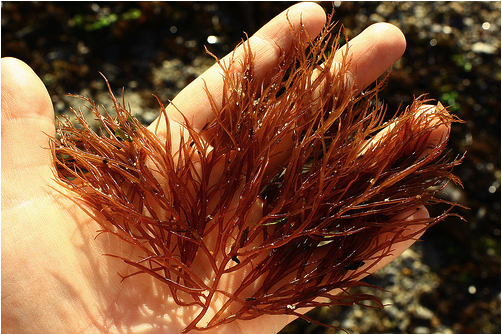At MACNA XXI two weeks ago, I had the honor of doing a workshop on propagating my favorite  macroalgae, Gracilaria. This genus has a lot going for it, as far as us fish geeks are concerned: it is readily available, propagates relatively easily once you get the hang of it, and is one of the best supplemental foods for herbivorous fishes such as Surgeonfishes and Rabbitfishes. The genus Gracilaria encompasses about 40 species. The genus name means “slender†or “delicateâ€, and this certainly describes this macroalgae well. It’s a distinctly different macroalgae than the usual “green and leafy†appearing ones that we have come to know and love. Let the “reef raff†have their Caulerpa- give me Gracilaria! The species that is most commonly encountered in the aquarium trade is Gracilaria parvispora, a deep red macroalgae that grows in a floating mass of fronds known as thalli. This macroalgae is known locally in the Hawaiian Islands and the North American “foodie†scene as “Ogoâ€, and has been propagated for centuries by the Hawaiian people for human consumption. An economically important algae, Gracilaria is utilized in a variety of Hawaiian and Asian dishes. As Rich Ross so eloquently put it during my demo (while I was munching on it)- “It’s the new Radicchio!†Look out, “Iron Chefsâ€!
As an aquarium species, G. parvispora grows rapidly, and is a highly efficient processor of micronutrients in closed systems. And did I mention that herbivorous fish REALLY like to eat it? Yeah, I did.  Propagation of this species is a relatively simple matter, despite the popular misconception that it’s finicky. Like your dog, significant other, or favorite PC (sorry- I’m a Mac user), it just wants what it wants. Make it happy  and it will thrive, providing you and your fishy friends with a personal supply of tasty macroalgae! You can use just about any kind of container that holds water to grow this stuff in. An old salt bucket (like you don’t have any of those lying around, right?), standard aquarium, or even one of those Rubbermaid cattle feed troughs (if you’re going big) will do the trick. For lighting, you can use almost any simple light fixture, ranging from sexy metal halides, to T5s, or PCs will work. Even standard wattage fluorescents will suffice. The key is to use daylight “flavored†bulbs (5,500k-10,000K works), and a sponge filter or powerhead to provide moderate water movement. Nutrient-rich water from the display aquarium, removed during regular water changes (you do those- right?), is ideal for this species.
Making your “Ogo†grow- grow!!!
One of the keys to success in propagating Gracilaria is to keep the algae in constant motion within the water column. This is where most would-be Gracilaria farmers blow it. This helps to keep detritus, debris, and epiphytic materials  (ie; crap) from settling among the fronds. The water flow should keep the algae moving without damaging the fronds. You’ll have to play around with the flow a bit, but you’ll get the idea once you see it…All we want is a gentle tumbling motion. Leave the high flow for your “War Coral†and designer Porites (there must be a “designer†Porites, right?)…gentle tumbling..Think gentle tumbling.
Summary of  hot tips for growing Gracilaria:
1) Cut down the salt- Gracilaria tends to grow better in slightly lower specific gravities than we normally use in reef systems. Try diluting your water to 1.010-1.021.
2) Keep ‘em warm- Shoot for 78-80 degrees F to encourage rapid nutrient uptake and growth with the tropical varieties
3) Let the sun shine- If you’re not using natural sunlight, be sure to use 5,500K-10,000k bulbs.
4) Feed your macroalgae- I have enjoyed much success by using Sea Chem Flourish Excel or Kent Marine Pro Plant. Follow manufacturer’s dosage recommendations. Don’t overdo it, or you’ll enjoy your new Hair Algae farm immensely!
5) Did I say “tumble the stuff†enough times?- Just do it, baby! Trust me.
Under proper conditions, it is possible to achieve a substantial increase in biomass (150% or more) on a monthly basis! That’s a lot of Tang food! Commercial operations, blessed with natural sunlight and large water volumes, can achieve biomass increases of up to 400% per month when conditions are optimal! That means not only fat and happy Tangs- but potentially fat wallets, too! Think about the commercial possibilities if you can supply this stuff to the local reef community! You’ll be able to buy a lot more super-sexy-ultra-trendy grade coral frags now! That will keep your local coral farmer happy! Ok, enough already…I’m making a salad for dinner- need to harvest some more Ogo. Till next time… stay wet.
Scott Fellman
Photo by FlickR user Seaweed Lady




